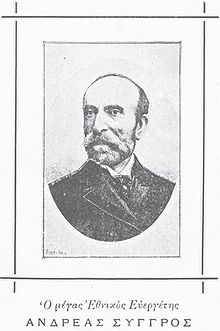Andreas Syggros (Greek: Ανδρέας Συγγρός; 12 October 1830 – 13 February 1899) was a Greek banker from Istanbul, at the time known internationally as Constantinople, and a philanthropist. Born in Istanbul to Chiot parents who left the island due to the Massacre of Chios, Syggros was one of the founders of the Bank of Constantinople along with Stephanos Skouloudis. Syggros married Iphigenia Mavrokordatou of the wealthy merchant Mavrocordatos family; they never had any children. They moved to Athens in 1871 where Syggros planned to found a new bank. Buying land from the widow of Dimitrios Rallis, Syggros engaged the well-known Athenian architect Nikolaos Soutsos who built his home based on plans by the German Ernst Ziller, across from the Royal Palace.[1] Today the mansion is the headquarters of the Greek Foreign Ministry, having been left to the state by his widow.
Andreas Syggros | |
|---|---|
 | |
| Born | 12 October 1830 |
| Died | 13 February 1899 (aged 68) |
| Nationality | Greek |
| Occupation(s) | banker, philanthropist |
He, together with other members of the Constantinople Greek diaspora and the Odessa Greek diaspora, led by Evangelis Valtatzis, founded the General Credit Bank (Ethniki Pistotiki Trapeza).[2]
In 1873, he profited from the stock market scandal that followed the Lavreotika dispute, having previously raised the price of the Greek Company of Lavrion Mines stocks by maintaining or spreading false rumors about the existence of gold reserves in the mines.[3]
In 1882, he founded the Privileged Bank of Epirothessaly in Volos to help the economy of the newly annexed Greek territories of Epiros and Thessaly. The annexation led to an influx of investment from expatriates who bought large estates previously belonging to Muslims who had made investments in the area. The "Privileged" in the bank's name refers to the bank receiving the right to issue banknotes in these territories.[4] The National Bank of Greece acquired the bank after Syggros's death.[5]
Syggros also became involved in numerous works of public philanthropy, including building an avenue from the Royal Palace to the bay at Palaio Faliro (named after him today, Andrea Syggrou Avenue) and he was responsible for completing the Corinth Canal, one of the great feats of engineering in Greece, in 1893. Syggros died in Athens in 1899, and is buried in the First Cemetery of Athens.
References
edit- ^ Greek Foreign Ministry Archived November 21, 2007, at the Wayback Machine
- ^ Levantine Heritage Archived August 27, 2006, at the Wayback Machine
- ^ "Η μεγαλύτερη φούσκα όλων των εποχών. Τα λαυρεωτικά, όταν οι Έλληνες πούλαγαν τα χωράφια τους για να αγοράσουν μετοχές, ενώ δεν υπήρχε καν χρηματιστήριο. Έχασαν όλοι εκτός από τον Συγγρό". ΜΗΧΑΝΗ ΤΟΥ ΧΡΟΝΟΥ (in Greek). 2019-10-01. Retrieved 2023-01-14.
- ^ Ray Chaudhuri, Ranajoy (2018). Central bank independence, regulations, and monetary policy : from Germany and Greece to China and the United States. New York, NY. ISBN 978-1-137-58912-5. OCLC 1062361508.
{{cite book}}: CS1 maint: location missing publisher (link) - ^ Petrakis, Panagiotis E. (2020). The evolution of the Greek economy : past challenges and future approaches. Pantelis C. Kostis. Cham, Switzerland. ISBN 978-3-030-47210-8. OCLC 1202754481.
{{cite book}}: CS1 maint: location missing publisher (link)